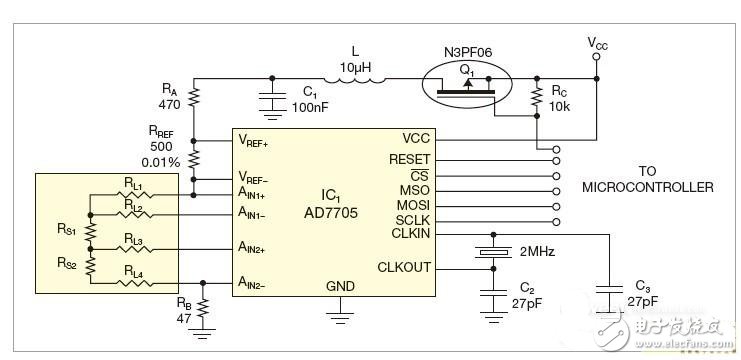Resistive pressure sensors with dual resistive components and four conductors are widely used in a variety of pressure monitoring applications. When the pressure rises, the resistance of one resistor increases and the other resistor decreases. Accurate measurements with resistive sensors require compensation for losses due to line resistance, especially when the line length reaches tens of meters. The basis of the compensation method in this example is that the wires have equal resistance: RL1 = RL2 = RL3 = RL4 = RL (Figure 1).

Figure 1. The measurement circuit measures the value of three points and the microcontroller can calculate the sensor value.
The microcontroller or computer can calculate the resistance of the sensor through the differential voltage across sensor elements RS1 and RS2. Resistors RA, RREF, and RB and sensor resistance limit the current through RS1 and RS2. The circuit uses AnalogDevices' AD7705ADC to measure sensor values. It has three pseudo differential inputs that provide 16-bit resolution. In this application, the AD7705 operates in buffer mode, ie, the input bias current is less than 1nA. In buffered mode, the analog input can withstand large source impedances, but the absolute input voltage must be increased from ground to 50mV until the drain-drain voltage is reduced by 1.5V. Resistor RB provides an input common mode voltage.
The measurement depends on the value of the reference resistor RREF. To get the highest accuracy, RREF must have a tolerance of 0.01% and must have a small temperature coefficient. In order to avoid self-heating of the sensor, the excitation current should be provided in a pulsed manner; the software controls the width of the pulse through Q1.
AIN1+, AIN1 - calculate RL;
AIN2+, AIN2- calculate RS2+RL;
AIN1-, AIN2- calculates RS1+RS2+RL.
The resistors RS1 and RS2 can be calculated by subtraction. The AD7705 has a PGA (Programmable Gain Amplifier) ​​for amplifying small input signals. The device has self-calibration and system calibration options that eliminate gain and offset errors in the device or system.
The pressure measurement depends on the resistance ratio and the temperature in the equation P=F(RS1/RS2, T). The parameter T is a compensation coefficient of the temperature dependence of the resistance sensor, T = F (RS1 + RS2).
Rice Transplanter Accessories,Rice Transplanter Spare Parts,Parts Of Rice Transplanter,Rice Transplanter Parts
Changzhou Youeryou Trading Co., Ltd. , https://www.farmpartssupplier.com